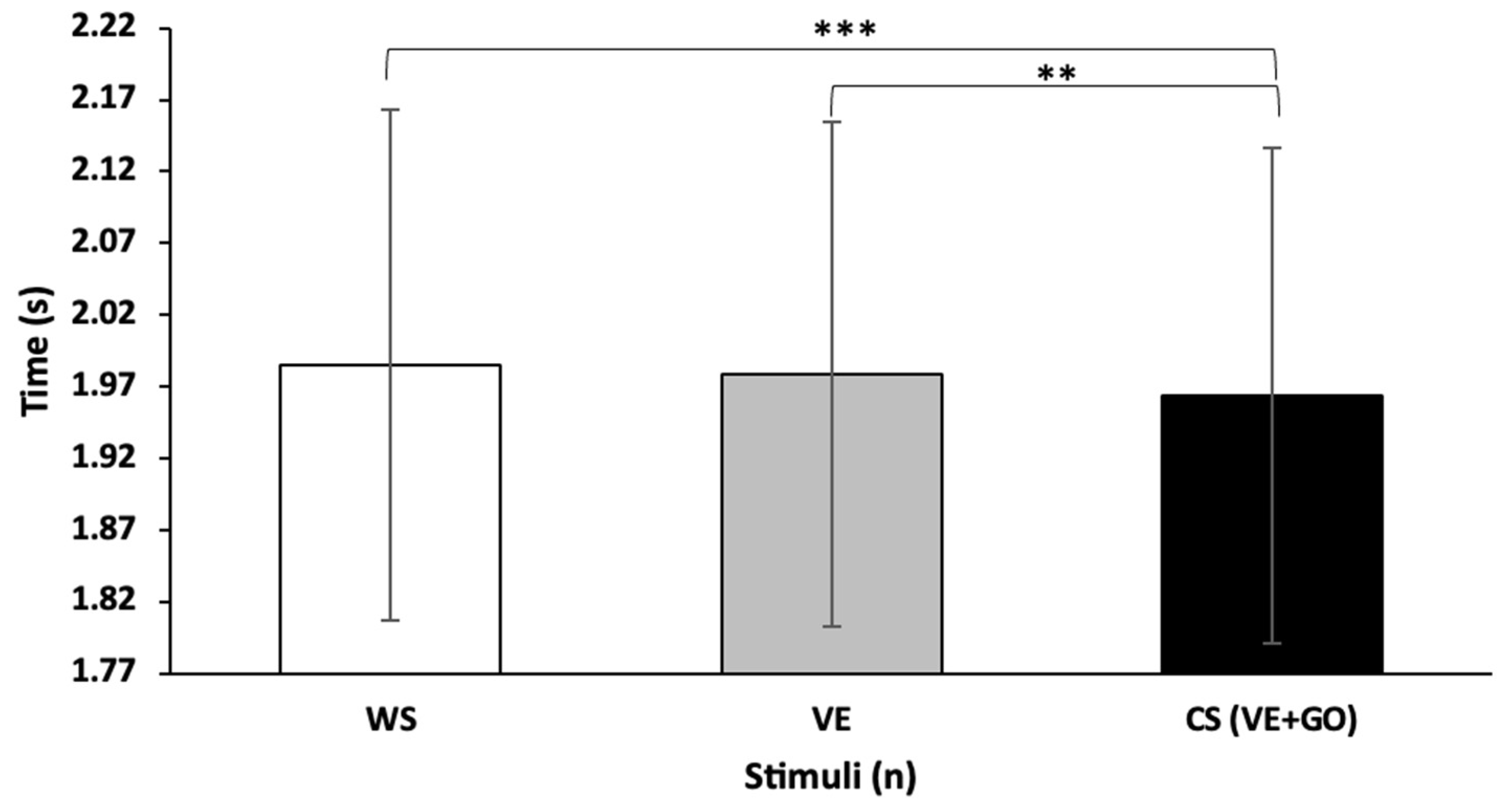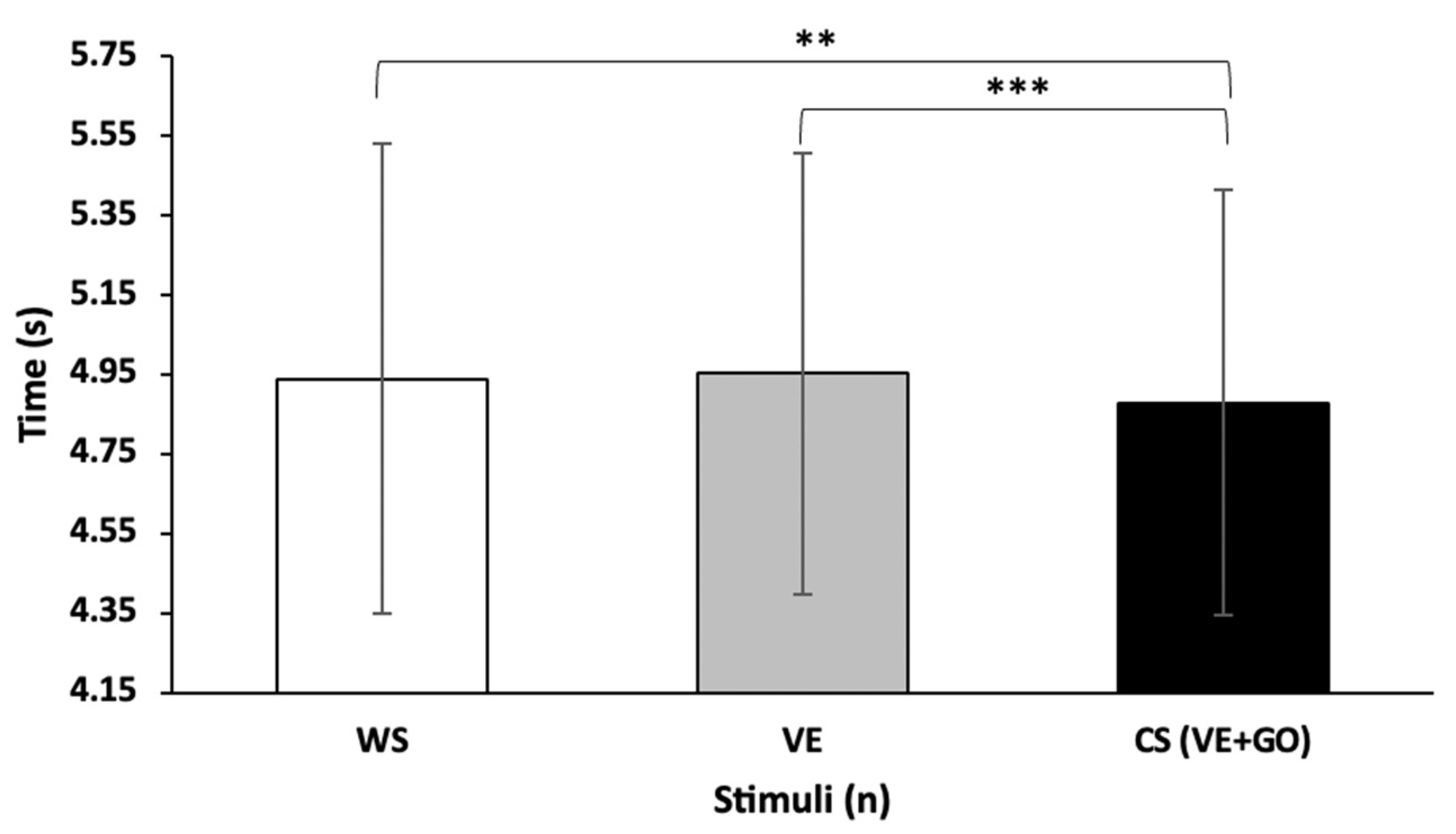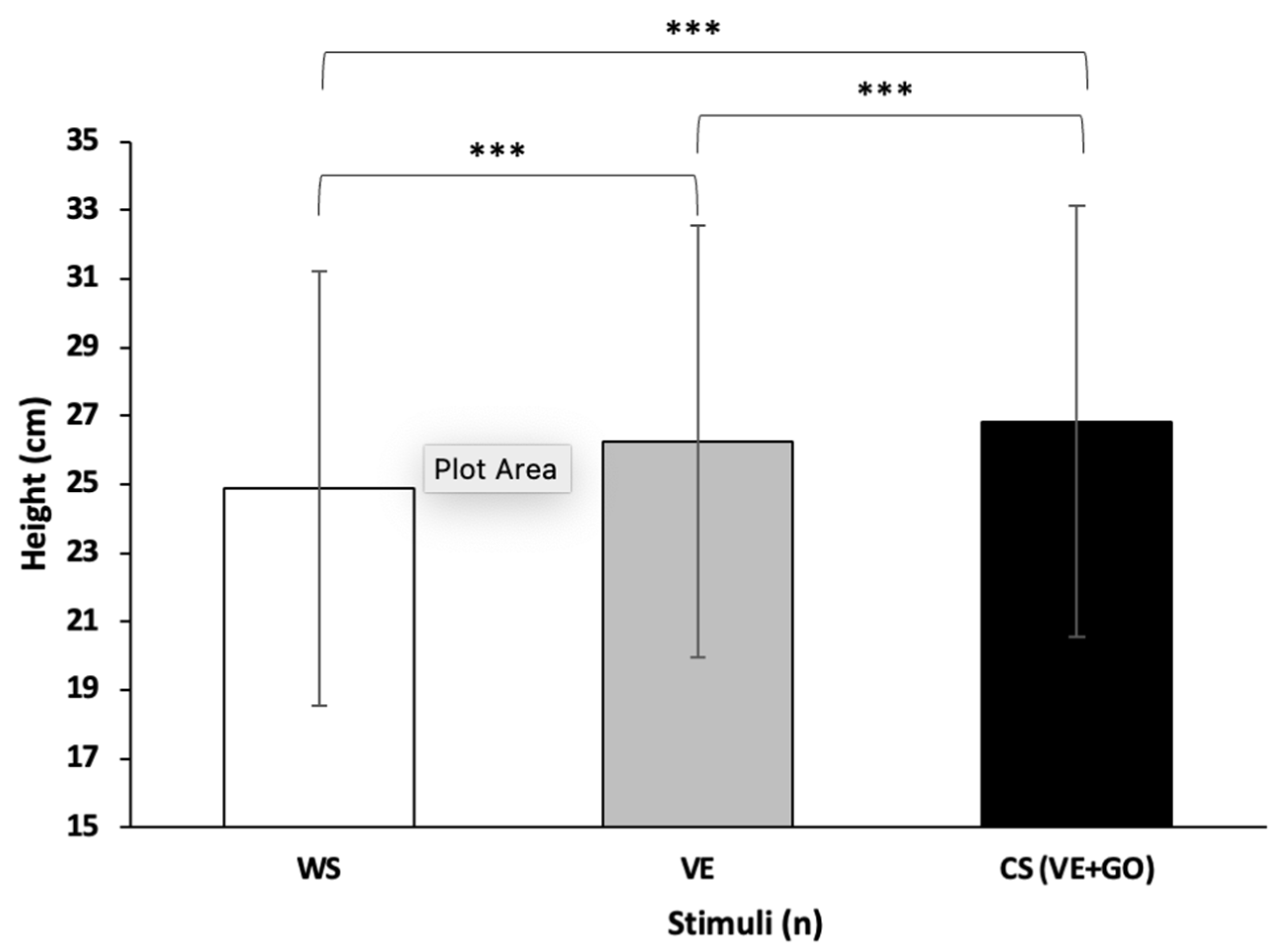Effects of Verbal Encouragement and Performance Feedback on Physical Fitness in Young Adults
Abstract
:1. Introduction
2. Materials and Methods
2.1. Participants
2.2. Questionnaires and Testing
- With external stimuli
- Verbal encouragement (VE—verbally motivate students;
- Performance feedback (PF—verbal feedback about their previous performance;
- Goal-oriented stimuli (GO)—reaching a certain goal-oriented aim;
- Combination of VE, PF and GO (CS).
- Without external stimuli—participants just performed particular tests without any external stimulus from examiner.
- Bench press—explosive strength of upper body;
- Sprints (10 and 30 m)—acceleration and speed;
- Vertical jump—explosive strength of lower body.
2.3. Characteristics of Selected Tests and Their Justification of Selection
2.3.1. Bench Press
- Students performed the exercise WS;
- PF was given to students about their maximal power from the previous repetition;
- Combination of PF and VE (“faster”, “go”);
2.3.2. The 10 and 30 m Sprint Tests
- Students ran alone WS;
- Students ran alone with VE from the examiner (“faster, go, go, go”) during the sprint.
2.3.3. Vertical Jump
- Vertical jump without any external stimuli;
- Vertical jump with a verbal encouragement from an examiner (“higher”);
- Vertical jump with an aim to touch a ball (hanging above the student) with the forehead and with verbal encouragement from an examiner.
2.4. Statistical Analyses
3. Results
4. Discussion
5. Conclusions
Practical Application
Author Contributions
Funding
Institutional Review Board Statement
Informed Consent Statement
Data Availability Statement
Conflicts of Interest
References
- Ellliot, A.J.; Covington, M. Approach and Avoidance Motivation. Educ. Psychol. Rev. 2001, 13, 2. [Google Scholar]
- Egli, T.; Bland, H.W.; Melton, B.F.; Czech, D.R. Influence of age, sex and race on college students’ exercise motivation of physical activity. J. Am. Coll. Health 2011, 59, 399–406. [Google Scholar] [CrossRef] [PubMed]
- Bekinari, A. Verbal Aggressiveness and Leadership Style of Sports Instructors and Their Relationship with Athletes’ Intrisic Motivation. J. Creat. Educ. 2014, 5, 114–121. [Google Scholar] [CrossRef] [Green Version]
- Bam, A. Psychological Aspects of Physical Education. 2016. Available online: https://www.slideshare.net/BamAmintao/psychological-aspects-of-physical-education-65717489 (accessed on 11 November 2021).
- Winnick, J.; Porretta, D. Adapted Physical Education and Sport, 6th ed.; Human Kinetics: Champaign, IL, USA, 2017. [Google Scholar]
- Schunk, D.H. Self-efficacy, motivation, and performance. J. Appl. Sport Psychol. 1995, 7, 112–137. [Google Scholar] [CrossRef] [Green Version]
- Reinboth, M.; Duda, J.L.; Ntoumanis, N. Dimensions of coaching behavior, need satisfaction, and the psychological and physical welfare of young athletes. Motiv. Emot. 2004, 28, 297–313. [Google Scholar] [CrossRef] [Green Version]
- Nicaise, V.; Cogérino, G.; Bois, J.; Amorose, A. Students’ perceptions of teacher feedback and physical competence in physical education classes: Gender effects. J. Teach. Phys. Educ. 2006, 25, 36–57. [Google Scholar] [CrossRef] [Green Version]
- Badami, R.; VaezMousavi, M.; Wulf, G.; Namazizadeh, M. Feedback after good versus poor trials affects intrinsic motivation. Res. Q. Exerc. Sport 2011, 82, 360–364. [Google Scholar] [CrossRef]
- Smither, J.W.; London, M.; Reilly, R.R. Does performance improve following multisource feedback? A theoretical model, meta-analysis, and review of empirical findings. Pers. Psychol. 2005, 59, 33–66. [Google Scholar] [CrossRef]
- Strube, G.; Strand, B. Can Feedback Affect Motivation? Oahperd J. 2015, 52, 2015. [Google Scholar]
- Coker, C.A. Motor Learning and Control for Practitioners with Online Labs, 3rd ed.; Holcomb Hathaway: Scottsdale, AZ, USA, 2013. [Google Scholar]
- Koka, A.; Hein, V. Perceptions of teacher’s feedback and learning environment as predictors of intrinsic motivation in physical education. Psychol. Sport Exerc. 2003, 4, 333–346. [Google Scholar] [CrossRef]
- Amorose, A.J.; Horn, T.S. Intrinsic motivation: Relationships with collegiate athletes’ gender, scholarship status, and perceptions of their coaches’ behavior. J. Sport Exerc. Psychol. 2000, 22, 63–84. [Google Scholar] [CrossRef]
- Chelladurai, P.; Saleh, S.D. Dimensions of leader behavior in sports: Development of a leadership scale. J. Sport Psychol. 1980, 2, 34–45. [Google Scholar] [CrossRef]
- Halperin, I.; Pyne, D.B.; Martin, D.T. Threats to internal validity in exercise science: A review of overlooked confounding variables. Int. J. Sports Physiol. Perform. 2015, 10, 823–829. [Google Scholar] [CrossRef] [PubMed]
- ATS Committee on Proficiency Standards for Clinical Pulmonary Function Laboratories. ATS statement: Guidelines for the six-minute walk test. Am. J. Respir. Crit. Care Med. 2002, 166, 111–117. [Google Scholar] [CrossRef]
- American Thoracic Society. ATS/ACCP statement on cardiopulmonary exercise testing. Am. J. Respir. Crit. Care Med. 2003, 167, 211. [Google Scholar] [CrossRef]
- Ferguson, B. ACSM’s guidelines for exercise testing and prescription 9th Ed. 2014. J. Can. Chiropr. Assoc. 2014, 58, 328. [Google Scholar]
- Guyatt, G.H.; Pugsley, S.O.; Sullivan, M.J.; Thompson, P.J.; Berman, L.; Jones, N.L.; Fallen, E.L.; Taylor, D.W. Effect of encouragement on walking test performance. Thorax 1984, 39, 818–822. [Google Scholar] [CrossRef] [Green Version]
- Moffatt, R.J.; Chitwood, L.F.; Biggerstaff, K.D. The influence of verbal encouragement during assessment of maximal oxygen uptake. J. Sports Med. Phys. Fit. 1994, 34, 45–49. [Google Scholar]
- Chitwood, L.F.; Moffatt, R.J.; Burke, K.; Luchino, P.; Jordan, J.C. Encouragement during maximal exercise testing of type A and type B scorers. Percept. Mot. Ski. 1997, 84, 507–512. [Google Scholar] [CrossRef]
- Andreacci, J.L.; Lemura, L.M.; Cohen, S.L.; Urbansky, E.A.; Chelland, S.A.; Duvillard, S.P. The effects of frequency of encouragement on performance during maximal exercise testing. J. Sports Sci. 2002, 20, 345–352. [Google Scholar] [CrossRef]
- Bullinger, D.L.; Hearon, C.M.; Gaines, S.A.; Daniel, M.L. Concurrent verbal encouragement and Wingate anaerobic cycle test performance in females: Athletes vs. non-athletes. Int. J. Exerc. Sci. 2012, 5, 239. [Google Scholar] [CrossRef] [PubMed] [Green Version]
- Neto, J.M.; Silva, F.B.; De Oliveira, A.L.; Couto, N.L.; Dantas, E.H.; de Luca Nascimento, M.A. <b> Effects of verbal encouragement on performance of the multistage 20 m shuttle run. Acta Sci. Health Sci. 2015, 37, 25–30. [Google Scholar]
- McCormick, A.; Meijen, C.; Marcora, S. Psychological determinants of whole-body endurance performance. Sports Med. 2015, 45, 997–1015. [Google Scholar] [CrossRef] [PubMed] [Green Version]
- Midgley, A.W.; Marchant, D.C.; Levy, A.R. A call to action towards an evidence-based approach to using verbal encouragement during maximal exercise testing. Clin. Physiol. Funct. Imaging 2018, 38, 547–553. [Google Scholar] [CrossRef] [PubMed]
- Engel, F.A.; Faude, O.; Kölling, S.; Kellmann, M.; Donath, L. Verbal encouragement and between-day reliability during high-intensity functional strength and endurance performance testing. Front. Physiol. 2019, 10, 460. [Google Scholar] [CrossRef] [PubMed] [Green Version]
- Hammami, R.; Nebigh, A.; Selmi, M.A.; Rebai, H.; Versic, S.; Drid, P.; Jezdimirovic, T.; Sekulic, D. Acute Effects of Verbal Encouragement and Listening to Preferred Music on Maximal Repeated Change-of-Direction Performance in Adolescent Elite Basketball Players—Preliminary Report. Appl. Sci. 2021, 11, 8625. [Google Scholar] [CrossRef]
- Anzak, A.; Tan, H.; Pogosyan, A.; Brown, P. Doing better than your best: Loud auditory stimulation yields improvements in maximal voluntary force. Exp. Brain Res. 2011, 208, 237–243. [Google Scholar] [CrossRef]
- Belkhiria, C.; de Marco, G.; Driss, T. Effects of verbal encouragement on force and electromyographic activations during exercise. J. Sports Med. Phys. Fit. 2018, 58, 750–757. [Google Scholar] [CrossRef]
- Lee, H.; Shin, J.; Kim, D.; Park, J. Effect of verbal encouragement on quadriceps and knee joint function during three sets of knee extension exercise. Isokinet. Exerc. Sci. 2021, 29, 155–162. [Google Scholar] [CrossRef]
- McNair, P.J.; Depledge, J.; Brettkelly, M.; Stanley, S.N. Verbal encouragement: Effects on maximum effort voluntary muscle: Action. Br. J. Sports Med. 1996, 30, 243–245. [Google Scholar] [CrossRef] [Green Version]
- Rheese, M.; Drinkwater, E.J.; Leung, H.; Andrushko, J.W.; Tober, J.; Hendy, A.M. The effects of verbal cueing for high intended movement velocity on power, neuromuscular activation, and performance. Scand. J. Med. Sci. Sports 2021, 31, 1115–1125. [Google Scholar] [CrossRef] [PubMed]
- Miller, W.; Jeon, S.; Kang, M.; Song, J.S.; Ye, X. Does Performance-Related Information Augment the Maximal Isometric Force in the Elbow Flexors? Appl. Psychophysiol. Biofeedback 2021, 46, 91–101. [Google Scholar] [CrossRef]
- Kraemer, W.J.; Fry, A.C.; Maud, P.; Foster, C. Physiological Assessment of Human Fitness. Strength Testing: Development and Evaluation Methodology; Maud, P., Foster, C., Eds.; Human Kinetics: Champaign, IL, USA, 1995; pp. 115–137. [Google Scholar]
- Pacholek, M. The influence of various stimuli on motivation and physical fitness of physically active and non-active students. Ann. Appl. Sport Sci. 2021, 9, e954. [Google Scholar] [CrossRef]
- Zemková, E. Stable to unstable differences in force–velocity-power profiling during chest presses and squats. J. Biomech. 2021, 122, 110463. [Google Scholar] [CrossRef] [PubMed]
- Jennings, C.L.; Viljoen, W.; Durandt, J.; Lambert, M.I. The reliability of the FiTRO Dyne as a measure of muscle power. J. Strength Cond. Res. 2005, 19, 167–171. [Google Scholar]
- Zemková, E.; Cepková, A.; Uvacek, M.; Šooš, L.U. A novel method for assessing muscle power during the standing cable wood chop exercise. J. Strength Cond. Res. 2017, 31, 2246–2254. [Google Scholar] [CrossRef] [PubMed]
- Zemková, E.; Jelen, M.; Kováciková, Z.; Ollé, G.; Vilman, T.; Hamar, D. Power outputs in the concentric phase of resistance exercises performed in the interval mode on stable and unstable surfaces. J. Strength Cond. Res. 2012, 26, 3230–3236. [Google Scholar] [CrossRef]
- Hamar, D. Výskokový ergometer—Princíp a možnosti uplatnenia v diagnostike trénovanosti a tréningovej praxi. In Príspevok z Pracovného Seminára Diagnostika a Rozvoj Odrazových Schopností; Tréningové Stredisko Salzburg-Riff: Hallein, Austria, 1991. [Google Scholar]
- Tkáč, M.; Hamar, D.; Komadel, L.; Kuthanová, O. Measurement of anaerobic power of the lower limbs by the method of repeated jumps. Sports Train. Med. Rehab. 1990, 1, 317–325. [Google Scholar] [CrossRef]
- Zemková, E.; Hamar, D. Jump Ergometer in Sport Performance Testing. Acta Univ. Palacki. Olomuc. Gymnica 2005, 35, 7–16. [Google Scholar]
- Argus, C.K.; Gill, N.D.; Keogh, J.W.; Hopkins, W.G. Acute effects of verbal feedback on upper-body performance in elite athletes. J. Strength Cond. Res. 2011, 25, 3282–3287. [Google Scholar] [CrossRef] [Green Version]
- Obmiñski, Z.; Mroczkowska, H. Verbal encouragement does not improve maximal isometric hand grip strength in male judokas. A short report. J. Combat. Sports Martial Arts 2015, 6, 63–66. [Google Scholar] [CrossRef]
- Silva, S.B.; de Abreu, L.C.; Valenti, V.E.; Nogueira, D.V.; Moraes, É.R.; Natividade, V.; Gallo, P.R.; Herrero, D.; Zacaro, P.M.D. Verbal and visual stimulation effects on rectus femoris and biceps femoris muscles during isometric and concentric. Int. Arch. Med. 2013, 6, 38. [Google Scholar] [CrossRef] [PubMed]
- Edwards, A.M.; Dutton-Challis, L.; Cottrell, D.; Guy, J.H.; Hettinga, F.J. Impact of active and passive social facilitation on self-paced endurance and sprint exercise: Encouragement augments performance and motivation to exercise. BMJ Open Sport Exerc. Med. 2018, 4, e000368. [Google Scholar] [CrossRef] [PubMed] [Green Version]
- Verheijen, R. The Original Guide to Football Periodisation: Always Play with Your Strongest Team, Part 1; World Football Academy: Amsterdam, The Netherlands, 2016. [Google Scholar]
- Porter, J.M.; Wu, W.F.; Crossley, R.M.; Knopp, S.W.; Campbell, O.C. Adopting an external focus of attention improves sprinting performance in low-skilled sprinters. J. Strength Cond. Res. 2015, 29, 947–953. [Google Scholar] [CrossRef] [PubMed]
- Vasconcelos, A.B.; Farinon, R.L.; Perasol, D.M.; dos Santos, J.M.; de Freitas, V.H. Influência de estímulos motivacionais no desempenho em testes de salto vertical de atletas de futsal sub-17. Revista Brasileira de Educação Física e Esporte 2020, 34, 727–733. [Google Scholar] [CrossRef]
- Porter, J.M.; Anton, P.M.; Wu, W.F. Increasing the distance of an external focus of attention enhances standing long jump performance. J. Strength Cond. Res. 2012, 26, 2389–2393. [Google Scholar] [CrossRef] [PubMed]
- Keller, M.; Lauber, B.; Gottschalk, M.; Taube, W. Enhanced jump performance when providing augmented feedback compared to an external or internal focus of attention. J. Sports Sci. 2015, 33, 1067–1075. [Google Scholar] [CrossRef]
- Ekkekakis, P.; Parfitt, G.; Petruzzello, S.J. The pleasure and displeasure people feel when they exercise at different intensities: Decennial update and progress towards a tripartite rationale for exercise intensity prescription. Sports Med. 2011, 41, 641–671. [Google Scholar] [CrossRef]




Publisher’s Note: MDPI stays neutral with regard to jurisdictional claims in published maps and institutional affiliations. |
© 2022 by the authors. Licensee MDPI, Basel, Switzerland. This article is an open access article distributed under the terms and conditions of the Creative Commons Attribution (CC BY) license (https://creativecommons.org/licenses/by/4.0/).
Share and Cite
Pacholek, M.; Zemková, E. Effects of Verbal Encouragement and Performance Feedback on Physical Fitness in Young Adults. Sustainability 2022, 14, 1753. https://doi.org/10.3390/su14031753
Pacholek M, Zemková E. Effects of Verbal Encouragement and Performance Feedback on Physical Fitness in Young Adults. Sustainability. 2022; 14(3):1753. https://doi.org/10.3390/su14031753
Chicago/Turabian StylePacholek, Martin, and Erika Zemková. 2022. "Effects of Verbal Encouragement and Performance Feedback on Physical Fitness in Young Adults" Sustainability 14, no. 3: 1753. https://doi.org/10.3390/su14031753
APA StylePacholek, M., & Zemková, E. (2022). Effects of Verbal Encouragement and Performance Feedback on Physical Fitness in Young Adults. Sustainability, 14(3), 1753. https://doi.org/10.3390/su14031753






